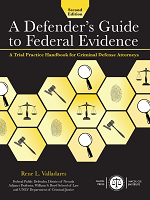Access to The Champion archive is one of many exclusive member benefits. It’s normally restricted to just NACDL members. However, this content, and others like it, is available to everyone in order to educate the public on why criminal justice reform is a necessity.
I recently had the pleasure of meeting Dick Burris, the U.S. Probation Officer for the Eastern District of Missouri, at an NACDL seminar. He has been called the “James Brown” of probation officers because he used recidivism risk reduction programs to turn his district around from the third highest district for recidivism to the 68th. Pleasant and driven, he is the hardest working probation officer in the business. One of the judges in his district remarked that he had gone from spending Friday afternoons revoking supervised release and probation to playing golf. This probation office enhances the criminal justice system instead of just adding to our over-burgeoning prison population.
Burris shared an unusual e-mail from one of his officers. It asked if he actually needed to send notice to the judge that he would be seeking a downward variance since the office routinely did so. Most of us have been waiting to see just one of these from our local probation offices. At the St. Petersburg, Florida, Federal Sentencing Seminar,1 Judge Shira Scheindlin observed, “It would be nice to have the support of a creative and engaged probation office.” Judge Scheindlin, part of a stellar panel on alternatives to incarceration, said that imprisoning people does not always make sense. She allowed that some persons needed to be kept out of society for the safety of the community. But she observed that so often inmates leave prison after serving long terms without having obtained even a GED. Failure to achieve even this benchmark to improve a prisoner’s lifestyle is a gross failure of the system. Locking people up and throwing away the key is like playing with matches and expressing surprise when a fire starts. Under current circumstances, what do we expect inmates serving long sentences to do once they re-enter society?
Burris chose education, employment, and rehabilitation programs to achieve his great results. And he gave credit to criminal defense lawyers for the change. He came into office after a ground swell of complaints and criticism from the defense bar regarding the high revocation rates in St. Louis. In response, the U.S. Probation Office hired its next chief from without. In came Burris.
With no more than a normal budget, Burris used the Department of Labor apprentice programs, tax breaks, Second Chance Act money, and elbow grease to arm persons on supervised release with an education, job training, job apprenticeships, and rehabilitation. He emphasized the triple approach because of the effect that each component has on recidivism. Drug rehabilitation reduces recidivism 16 percent, education reduces it 16 percent, Unicor2 reduces it 23 percent, and apprenticeships reduce it 33 percent.
The criminal defense lawyers in his district took it further. Seeing the good things Burris was doing on the back end, they began to employ his techniques on the front end to encourage a downward variance at sentencing. They employed education, apprenticeships, jobs, and rehabilitation as alternatives to incarceration. Judge Scheindlin, from New York, has been using a combination of adjournments and rehabilitation to achieve holistic justice; correction and punishment for offenders that diminish or defeat recidivism. NACDL Board Member Rick Jones added that when NACDL studied problem-solving courts, it learned the important components of drug abuse rehabilitation programs within the criminal justice system.3 He addressed details necessary for success while adding that we would all be much better served if rehabilitation occurred within the public health domain. Rick has always been an inspiration to me. Dick Burris and Judge Scheindlin are two new heroes of mine.
Each was armed with no more resources than their contemporaries, and each has been a genius with the resources at their disposal. We need to follow their example.
These techniques do not work overnight. Each effort can lend to the other. Finding employers who will take a chance on an accused or convicted individual takes time. The tax breaks help a little, but Burris made sure it worked for them. If people had trouble getting to work, Burris found them a ride. He assured the employers that his office would provide this kind of support. He also invested the time to find out what kind of work persons under his supervision would enjoy. That is why the program is a win-win-win situation, as he put it.
Hearing about Burris’ work, Judge Scheindlin challenged criminal defense lawyers to meet with their chief judges and chief probation officers to demand the re-entry services offered by the Eastern District of Missouri. We should also be using these sensible techniques pretrial in order to obtain the downward variances that the Eastern District of Missouri recommends in 50 percent of its cases. I left the Federal Sentencing Guidelines program invigorated, thrilled to have met such giants in our profession, and never too proud to steal their genius for the betterment of our fellow man.
Notes
- St. Petersburg, Florida, Federal Sentencing Guidelines program was co-sponsored by the Federal Bar Association, the American Bar Association Criminal Justice Section, and NACDL. Kevin J. Napper did a wonderful job directing the course with our own Executive Director, Norman Reimer.
- “FPI [Federal Prison Industries, Inc.] is, first and foremost, a correctional program. The whole impetus behind Federal Prison Industries is not about business, but instead, about inmate release preparation … helping offenders acquire the skills necessary to successfully make that transition from prison to law-abiding, contributing members of society. The production of items and provision of services are merely by-products of those efforts.
…It is the mission of FPI to employ and provide job skills training to the greatest practicable number of inmates confined within the Federal Bureau of Prisons; contribute to the safety and security of our nation’s federal correctional facilities by keeping inmates constructively occupied; provide market-quality products and services; operate in a self-sustaining manner; and minimize FPI’s impact on private business and labor.” See Unicor, http://www.unicor.gov. - America’s Problem-Solving Courts: The Criminal Costs of Treatment and the Case for Reform; see www.nacdl.org/drugcourts.






